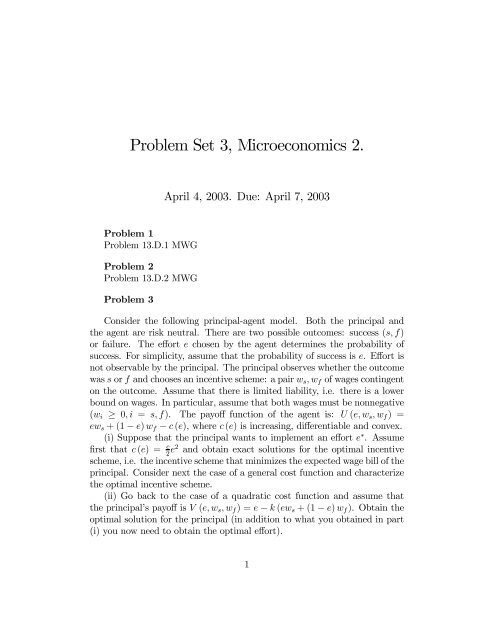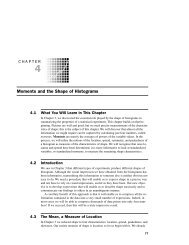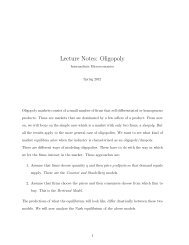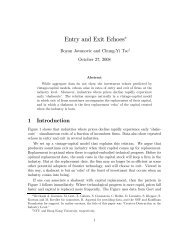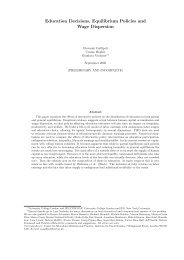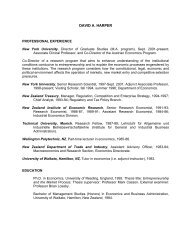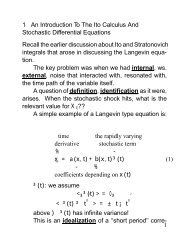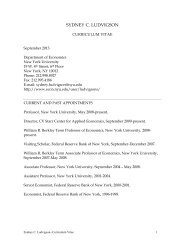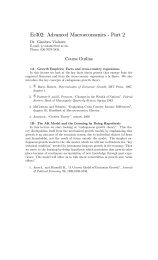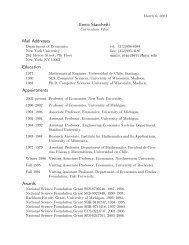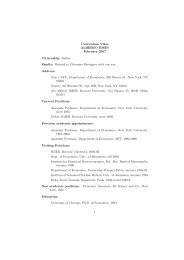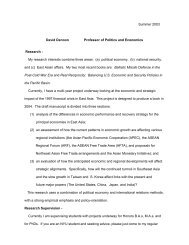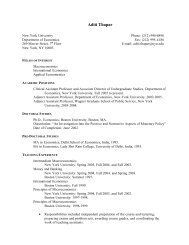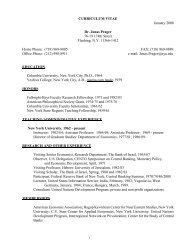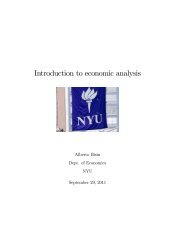Problem Set 3, Microeconomics 2.
Problem Set 3, Microeconomics 2.
Problem Set 3, Microeconomics 2.
Create successful ePaper yourself
Turn your PDF publications into a flip-book with our unique Google optimized e-Paper software.
<strong>Problem</strong> <strong>Set</strong> 3, <strong>Microeconomics</strong> <strong>2.</strong><br />
April4,2003.Due:April7,2003<br />
<strong>Problem</strong> 1<br />
<strong>Problem</strong> 13.D.1 MWG<br />
<strong>Problem</strong> 2<br />
<strong>Problem</strong> 13.D.2 MWG<br />
<strong>Problem</strong> 3<br />
Consider the following principal-agent model. Both the principal and<br />
the agent are risk neutral. There are two possible outcomes: success (s, f)<br />
or failure. The effort e chosen by the agent determines the probability of<br />
success. For simplicity, assume that the probability of success is e. Effort is<br />
not observable by the principal. The principal observes whether the outcome<br />
was s or f and chooses an incentive scheme: a pair w s ,w f of wages contingent<br />
on the outcome. Assume that there is limited liability, i.e. there is a lower<br />
bound on wages. In particular, assume that both wages must be nonnegative<br />
(w i ≥ 0,i = s, f). The payoff function of the agent is: U (e, w s ,w f ) =<br />
ew s +(1− e) w f − c (e), wherec (e) is increasing, differentiable and convex.<br />
(i) Suppose that the principal wants to implement an effort e ∗ . Assume<br />
first that c (e) = c 2 e2 and obtain exact solutions for the optimal incentive<br />
scheme, i.e. the incentive scheme that minimizes the expected wage bill of the<br />
principal. Consider next the case of a general cost function and characterize<br />
the optimal incentive scheme.<br />
(ii) Go back to the case of a quadratic cost function and assume that<br />
the principal’s payoff is V (e, w s ,w f )=e − k (ew s +(1− e) w f ). Obtain the<br />
optimal solution for the principal (in addition to what you obtained in part<br />
(i) you now need to obtain the optimal effort).<br />
1
(iii) Assume now that there is an additional outcome that we call h (for<br />
high success). The probability of outcome h given e is e 2 . The incentive<br />
scheme is now made up of three elements: w h ,w s ,w f and the utility of the<br />
agent is given by U (e, w) =w h e 2 +w s e+w f (1 − e − e 2 )−c (e). Assume that<br />
c 000 (e) ≥ 0 (yes, the third derivative) for every e ∈ [0, 1]. Suppose that the<br />
principal wants to implement effort e ∗ and characterize the optimal incentive<br />
scheme. Note: make sure that you check second order conditions. You may<br />
want to start by looking at the quadratic case first (c (e) = c 2 e2 ).<br />
(iv) (Only if you are curious. Still the case of three outcomes.) Assume<br />
that c(e) =e 3 2 . This means that, although c is convex, c 000 (e) < 0. Characterize<br />
the optimal incentive scheme for implementing e ∗ (nothing more,<br />
nothing less).<br />
<strong>Problem</strong> 4<br />
Consider the following principal-agent problem. The observable outcome<br />
is the profit π of the principal. The agent chooses effort e ∈ [0, ∞). Effort<br />
is not observable by the principal. Assume that the density of profits<br />
conditional on effort (f (π|e)) is uniform on [e, e +1]. The agent’s payoff<br />
is U (w, e) =v (w) − c (e) where v is strictly increasing, strictly concave,<br />
and unbounded below, and c is convex. The principal is risk neutral and<br />
maximizes expected profits minus the expected wage bill. Assume that the<br />
agent’s reservation utility is zero.<br />
(i) Assume that the principal wants to implement effort e ∗ > 0 and characterize<br />
the optimal incentive scheme. Obtain an exact expression for the<br />
expected wage bill required to implement e ∗ in the optimal incentive scheme.<br />
Hint 1: pointwise maximization may not be the best approach. Hint 2: you<br />
have to use the fact that some outcomes are impossible for some efforts.<br />
(ii) Assume now that v (w) = log(w) and c (e) = e2 and obtain the<br />
10<br />
optimal effortchoicefortheprincipal.<br />
2


